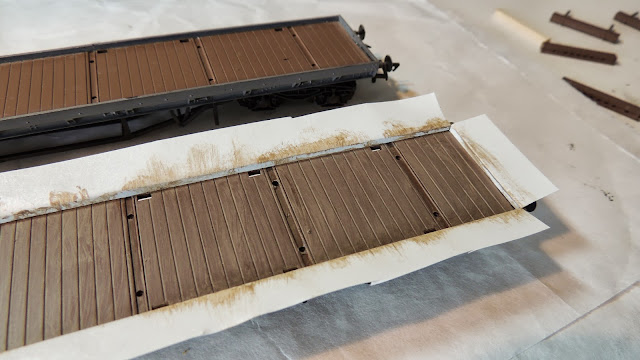Here are some wagons to demonstrate the techniques I found helpful in adding a touch of realism to your roster of freight cars.
I try to be accurate as far as the Thomas show and the Railway Series, but I always look at any photographs I can find of real 7-plank open wagons, so I can have a better understanding as how to weather them. I think that is vital to achieving realism and believability for painting and weathering rolling stock.
So here we go:
Here is a wagon painted in the green paint scheme seen from Season 2 to the new seasons. I have used many wagons of Bachmann Trains' lineup of Thomas rolling stock, thought I found Bachmann Branchline being the best choice for rolling stock, twice the model quality and realism at a better price for the pound!

I use acrylic FolkArt paints to color and weather these cars. the main body is painted a dark green, with black for the bolts and underframe. Care was taken to paint the chains on the door, and add hints of rust and grime on the body and the parts.
Inside are ties, a large barrel and some spare wheels painted to look old and ready for the scrap yard.
This is the main color type for wagons found on the TV series, though there are many other wagons with different colors for the aging of the wood and debris from the loads they carry.
For this planned consist, this wagon is brown with plenty of dust and rust! I used a combination of acrylic and scraped pastel dust to weather this wagon. Many professional model railroaders use this technique for their models, and it was great to try it out for the first time, matte finish at hand!
This car is heavily weathered, and I think the more variation of how each car is painted the better for achieving realism.
Inside the wagon in this photo are some spare parts and kits painted as wagon loads. Any scrap
piece of leftovers from kit building is a must for added detail for any
model railroad, very useful for scrap, cargo, and elements that add
interest on your layout, as well as for freight cars.
Without the cargo, you can see here traces of soot and grime from coal dust on the boards in the wagon. a lot of black pastel was scraped and smeared with a finger and a brush.
For this wagon, I painted it in a gray-black, Great Western color scheme, full of ballast dust from the harbor or the quarry. This is a double-ended, 7-plank open wagon.
It took a few coats of the black with different shades of gray to get the look I want, with weathering colors such as nutmeg for rust, with a few dabs of paint on the bolts, and mushroom for the ballast.
In the wagon here are some weathered Lego chains, and a pile of fishing nets, made from scrap onion plastic casing! Primer spray paint and a little pastel powder is all that is needed to weather them.
I recommend purchasing Bachmann and Hornby items of
ehattons.com, in great prices and great service.
There are many freight cars and coaches planned for remakes, to fill the yards and make extra train consists!





















































